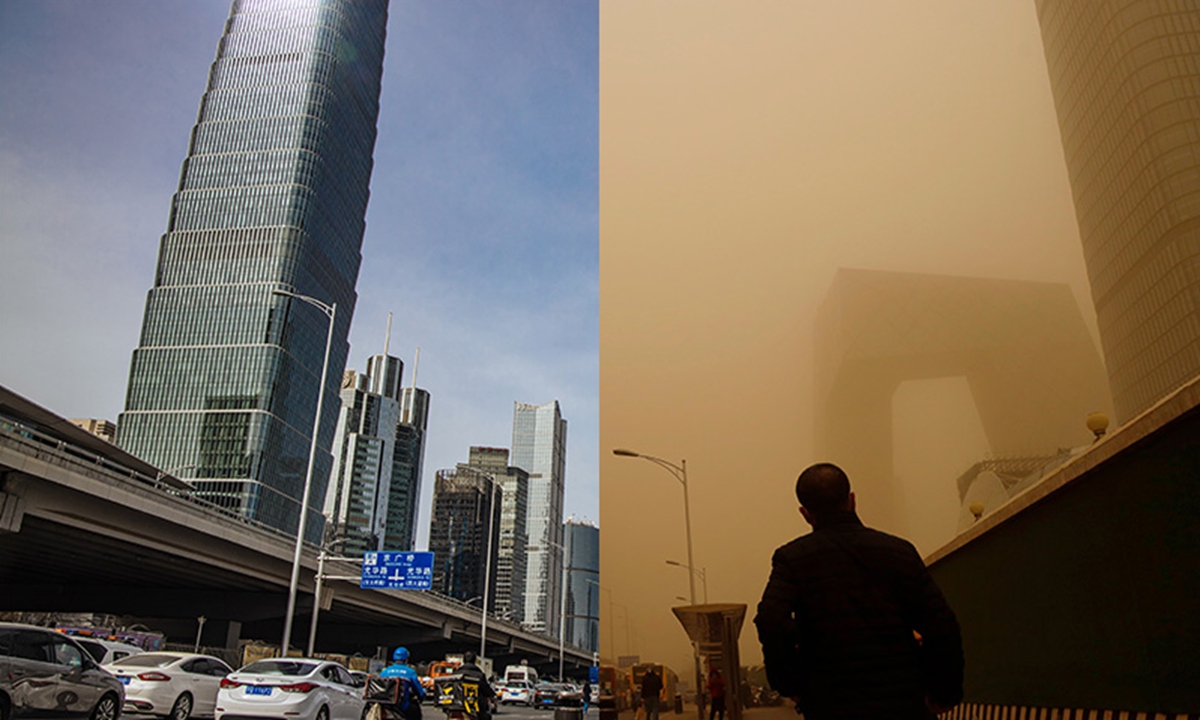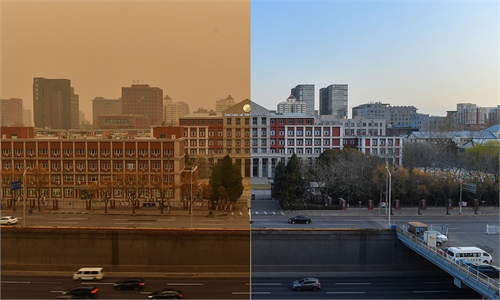S.Korean media blasted for blaming sandstorm on China
China is just a country that the dust ‘passed through’

After being enveloped by sand and dust for a whole day on Monday in the largest sandstorm in a decade, Beijing has cleared up and the yellow warning for sandstorms was lifted on Tuesday morning, with the city a picture of blue skies and sunshine. Photo: Li Hao/GT
Blue sky returned to Beijing on Tuesday after the city was enveloped by the largest sandstorm in a decade for a whole day. But a new "storm" was brewing online on Tuesday after Chinese netizens found that South Korean media blamed the sandstorm on China.
The sandstorm hit 12 provinces in northern China from west to east as it entered Chinese territory from the neighboring Mongolia late Sunday afternoon.
The western region of South Korea was also affected by sandstorms on Tuesday morning, according to a report by the Yonhap News Agency on Tuesday, quoting the Korean Meteorological Administration.
However, South Korean media said the sandstorm originated from China.
Chinese Foreign Ministry spokesperson Zhao Lijian on Tuesday refuted the South Korean media reports. Zhao said the sandstorm that hit China on Monday came from outside China, and he called for objective and scientific reports from the media.
China is just a country that the dust "passed through," Zhao noted.
Mongolian officials released relevant information on the damage caused by the sandstorm, but Chinese public opinion did not criticize Mongolia for possibly being the potential source of the sandstorm, Zhao said.
The issue should be viewed in a scientific and constructive manner. Public opinion should be guided in the right way to avoid unnecessary speculation and random labeling, he said.
South Korean media outlet Yonhap News Agency reported that the dust storm "originated from the inland deserts in northern China" and even highlighted the claim in the title of the Chinese version of the article. Other media reports also stressed the "baneful influence" that China has on South Korea's environment.
The South Korean media reports did not go down well on Chinese social media, which has recently been the major battlefield of a cultural feud between Chinese and South Korean netizens. The relevant topic on Sina Weibo had received more than 340 million views and more than 16,000 comments as of press time.
Some people accused South Korean media of false reporting and hyping an image of China being a "pollution-creating country." Others said that such biased reports will aggravate the prejudice of South Korean people against China and intensify bilateral tensions.
Besides South Korea, some other foreign media outlets claimed that the sandstorm originated in China and elaborately pointed to China's "responsibility" for the disaster.
"The sandstorm that reached South Korea on Tuesday ran a path from Mongolia to the southeast part of Inner Mongolia Autonomous Region to the Korean Peninsula," Wang Gengchen, a research fellow at the Institute of Atmospheric Physics of the Chinese Academy of Sciences, told the Global Times on Tuesday.
The reports should be based on scientific data, rather than bias, Wang said.
"Meteorological satellite monitoring can clearly see the source of the dust storm in Mongolia. The dust flew into China with the wind, and it will affect South Korea and other places," said Song Lianchun, director of the National Climate Center in China.
Weather monitoring showed that high surface temperatures and low precipitation earlier in Mongolia, as well as the unusually strong Mongolian cyclone moving eastward, provided the conditions for the large sandstorm, Song told the Global Times on Tuesday.
As of Tuesday noon, Mongolia had reported 10 deaths from the disaster. Another 580 people listed as missing had all been found.
Due to global warming, Mongolia's ecological problems have become increasingly prominent. Some 70 percent of the country's land is facing various degrees of desertification, and desert areas are showing a trend of continuous expansion.
Zhao also called for cooperation on environmental governance from the international community as the Chinese Minister of Ecology and Environment Huang Runqiu held a video conference with South Korean counterpart Han Jeoung-ae on Tuesday to discuss cooperation on tackling environmental problems and the second summit of Partnering for Green Growth and the Global Goals 2030.


